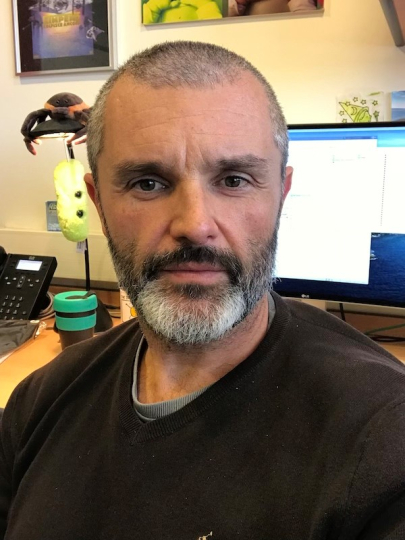Matteo BonazziInstitut de recherche en infectiologie de Montpellier » (IRIM) - CNRS / Université de Montpellier
Mes recherches
After a PhD in cellular biology (Consorzio Mario Negri Sud/Open University of London), I wanted to apply my knowledge of microscopy and membrane trafficking to the study of bacterial infections. I thus joined the laboratory of Prof. Pascale Cossart at the Pasteur Institute in Paris, for a 5 years post-doc, to study the role of receptor-mediated endocytosis and clathrin in the internalization of bacterial pathogens. During this time, I became interested in developing new, unbiased approaches to decipher the complex dialogue which is established between a pathogen and its host during infection. To this aim, I have applied to an ATIP-Avenir Grant in 2010 to start my independent career and focus on the development of screening approaches for the study of host/pathogen interaction using the intracellular bacterial pathogen Coxiella burnetii as a model system. Thus, I established my team in Montpellier at the IRIM in 2011 to start this new, exciting adventure. Nine years later, we have generated and screened the first library of Coxiella mutants, which has allowed us to identify an important number of virulence determinants, shedding light on this once neglected zoonotic pathogen. Moreover, the screening approaches that we have developed can be applied to the study of numerous intracellular bacterial pathogens, thus facilitating the identification of host/pathogen interaction hubs that can be targeted for the design of innovative antimicrobials.
Mon projet ATIP-Avenir
LARGE-SCALE IDENTIFICATION OF COXIELLA BURNETII VIRULENCE FACTORS
AttaQ
Coxiella burnetii is an obligate intracellular gram-negative bacterium responsible of the zoonosis Q fever, a disease that manifests as an acute flu-like illness. Due to its high infectivity it has been classified as a class B biothreat. In natural infections Coxiella mainly targets macrophages whereas in vitro is capable of infecting a wide variety of cell types. As several other pathogens Coxiella replicates in a large phagosomal vacuole, but differently from any other known pathogen, Coxiella has the capacity of thriving in a parasitophorous vacuole which is biochemically indistinguishable from lysosomes. Despite the interest that Coxiella infections raise, its obligate intracellular nature has hampered the research activity due to the impossibility of genetic manipulation and growth in broth. The mechanisms of subversion of host functions remain therefore obscure and the number of Coxiella virulence factors identified is, to date, very limited. The recent characterization of a specific growth medium that allows axenic growth of Coxiella opens the way to genetic engineering of the bacterium. The aim of this project is the large-scale identification of Coxiella virulence factors by generating a bank of mutants by transposon mutagenesis. This will be coupled to the setup of robust high throughput screens to identify phenotypes that will allow the characterization of virulence factors.
